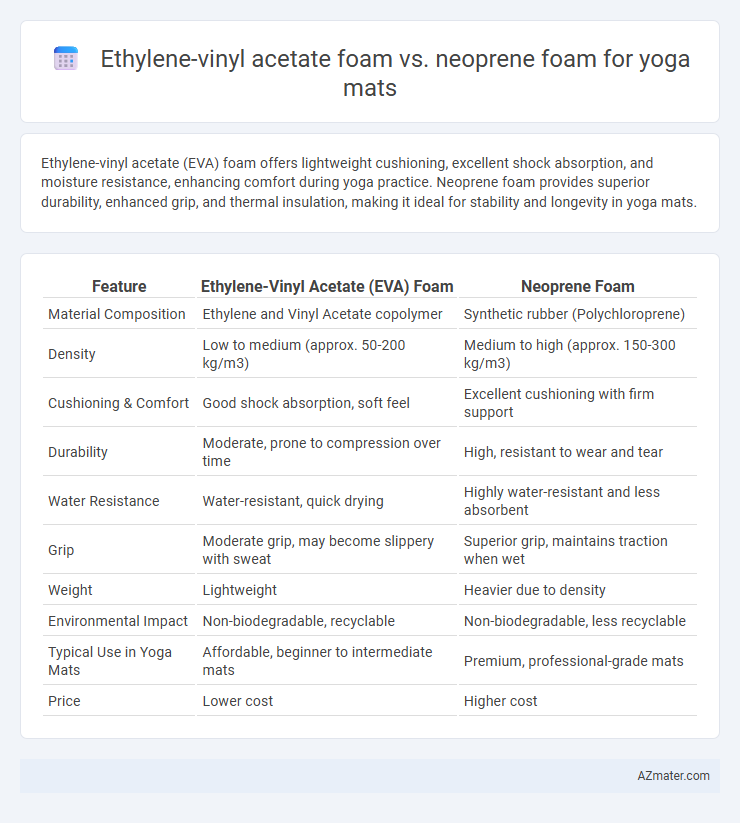Ethylene-vinyl acetate (EVA) foam offers lightweight cushioning, excellent shock absorption, and moisture resistance, enhancing comfort during yoga practice. Neoprene foam provides superior durability, enhanced grip, and thermal insulation, making it ideal for stability and longevity in yoga mats.
Table of Comparison
| Feature | Ethylene-Vinyl Acetate (EVA) Foam | Neoprene Foam |
|---|---|---|
| Material Composition | Ethylene and Vinyl Acetate copolymer | Synthetic rubber (Polychloroprene) |
| Density | Low to medium (approx. 50-200 kg/m3) | Medium to high (approx. 150-300 kg/m3) |
| Cushioning & Comfort | Good shock absorption, soft feel | Excellent cushioning with firm support |
| Durability | Moderate, prone to compression over time | High, resistant to wear and tear |
| Water Resistance | Water-resistant, quick drying | Highly water-resistant and less absorbent |
| Grip | Moderate grip, may become slippery with sweat | Superior grip, maintains traction when wet |
| Weight | Lightweight | Heavier due to density |
| Environmental Impact | Non-biodegradable, recyclable | Non-biodegradable, less recyclable |
| Typical Use in Yoga Mats | Affordable, beginner to intermediate mats | Premium, professional-grade mats |
| Price | Lower cost | Higher cost |
Introduction to EVA and Neoprene Foams
Ethylene-vinyl acetate (EVA) foam offers lightweight cushioning with excellent shock absorption, making it a popular choice in yoga mats for enhanced comfort and durability. Neoprene foam boasts superior elasticity, water resistance, and thermal insulation, which benefits yoga practitioners by providing grip and moisture management during intense sessions. Both foams differ in chemical composition and physical properties, impacting flexibility, resilience, and user experience in yoga mat applications.
Material Composition and Structure
Ethylene-vinyl acetate (EVA) foam used in yoga mats consists of a copolymer of ethylene and vinyl acetate, offering a lightweight, flexible, and shock-absorbing structure with closed-cell composition that resists water and bacteria. Neoprene foam, a synthetic rubber made from chloroprene, features an open-cell or closed-cell structure that provides superior durability, elasticity, and excellent thermal insulation, enhancing grip and comfort during yoga sessions. The material composition differences influence the foam's chemical resistance, cushioning properties, and overall user experience, making EVA ideal for lightweight portability and Neoprene preferred for durability and resilience.
Cushioning and Comfort Comparison
Ethylene-vinyl acetate (EVA) foam offers superior cushioning with a soft, flexible texture that absorbs impact effectively, making it ideal for high-comfort yoga mats. Neoprene foam provides moderate cushioning but excels in durability and resistance to compression, maintaining comfort over extended use. Yoga practitioners seeking plush comfort prioritize EVA for its lightweight, shock-absorbing properties, while neoprene is favored for enhanced support and longevity.
Durability and Longevity
Ethylene-vinyl acetate (EVA) foam offers superior durability for yoga mats due to its high resilience and resistance to cracking and UV exposure, ensuring long-lasting performance in regular practice. Neoprene foam, while providing excellent cushioning and a non-slip surface, tends to degrade faster under prolonged exposure to sweat and environmental factors, potentially reducing its lifespan. Choosing EVA foam enhances longevity through better resistance to wear and tear, making it ideal for intensive, frequent yoga sessions.
Weight and Portability
Ethylene-vinyl acetate (EVA) foam yoga mats are lightweight and highly portable, making them ideal for practitioners who travel frequently or require easy transportation. Neoprene foam mats tend to be denser and heavier due to their closed-cell structure, providing excellent cushioning but reducing portability. For lightweight and compact yoga mat options, EVA foam offers superior ease of carrying without compromising basic comfort.
Grip and Anti-Slip Performance
Ethylene-vinyl acetate (EVA) foam offers superior grip due to its closed-cell structure that provides cushioning and excellent traction on various surfaces, making it ideal for yoga mats. Neoprene foam, known for its rubber-like texture and high elasticity, delivers exceptional anti-slip performance by maintaining strong adherence to the floor and users' hands, even during sweaty sessions. When comparing grip and anti-slip qualities, EVA foam excels in lightweight comfort and shock absorption, while neoprene provides enhanced durability and consistent slip resistance in high-moisture environments.
Water and Sweat Resistance
Ethylene-vinyl acetate (EVA) foam offers excellent water and sweat resistance, making it a preferred choice for yoga mats used in hot and humid conditions or intense workout sessions. Neoprene foam also provides superior water resistance and durability but tends to retain more moisture due to its closed-cell structure, which can affect long-term hygiene. Both materials resist sweat absorption effectively, but EVA foam's lightweight and quick-drying properties enhance overall user comfort during yoga practice.
Eco-Friendliness and Safety
Ethylene-vinyl acetate (EVA) foam is favored for yoga mats due to its excellent cushioning, lightweight nature, and non-toxic properties, making it a safer choice for skin contact and indoor use. Neoprene foam, while durable and offering superior grip, often involves chloroprene production that poses environmental concerns, reducing its eco-friendliness compared to EVA foam. EVA stands out with lower emissions during manufacturing and better biodegradability, aligning more closely with eco-conscious consumer preferences for sustainable yoga gear.
Cost and Value Analysis
Ethylene-vinyl acetate (EVA) foam yoga mats typically offer a lower cost compared to neoprene foam mats, making them budget-friendly while providing adequate cushioning and durability for most users. Neoprene foam mats, although more expensive, deliver superior resilience, water resistance, and longer lifespan, enhancing overall value for intensive or professional yoga practice. The choice between EVA and neoprene ultimately depends on balancing initial investment with desired durability, comfort, and maintenance preferences.
Choosing the Best Foam for Your Yoga Practice
Ethylene-vinyl acetate (EVA) foam offers a lightweight, durable, and eco-friendly option for yoga mats, providing excellent cushioning and shock absorption ideal for high-intensity practice. Neoprene foam delivers superior grip and water resistance, making it perfect for hot yoga and sweaty conditions where mat stability is crucial. Selecting the best foam depends on your practice style and priorities: EVA suits those seeking comfort and flexibility, while neoprene is optimal for enhanced traction and moisture control.

Infographic: Ethylene-vinyl acetate foam vs Neoprene foam for Yoga Mat
 azmater.com
azmater.com